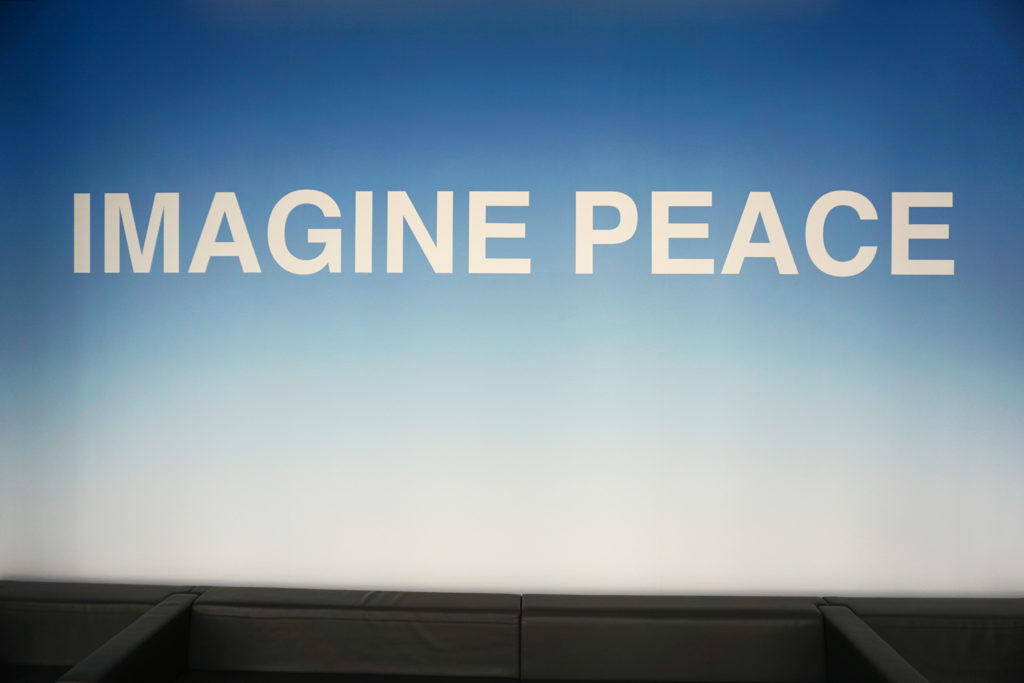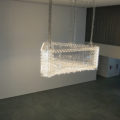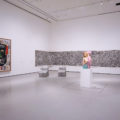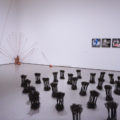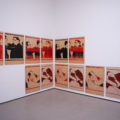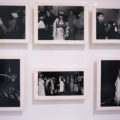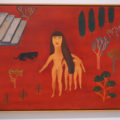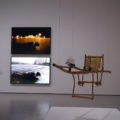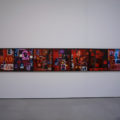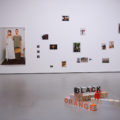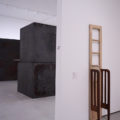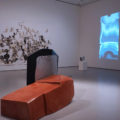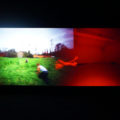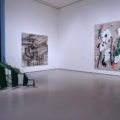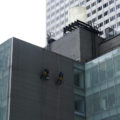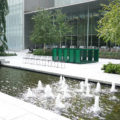[ad_1]
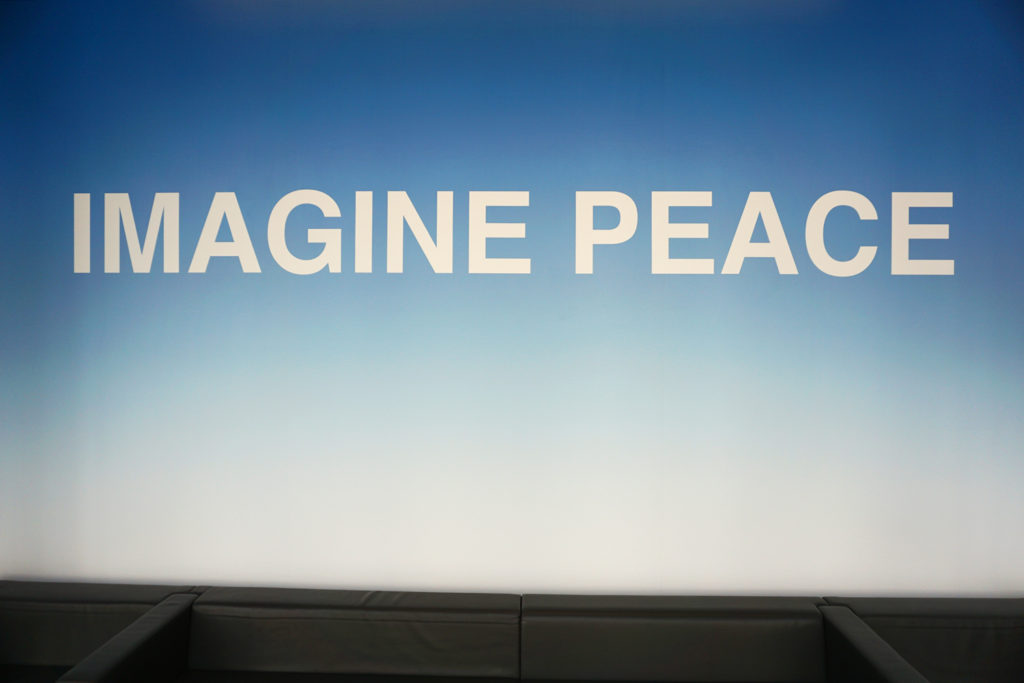
In a hallway is a stunning new commission by Yoko Ono that updates her famous billboard, a collaboration from 1969 with her late husband John Lennon, titled “WAR IS OVER! (if you want it).” Here, a detail of the new text-based piece, titled PEACE is POWER.
MAXIMILÍANO DURÓN
After a four-month-long closure and a $450 million renovation that has been years in the making the Museum of Modern Art in New York opened to members of the press on Thursday morning, October 10.
On its second floor second floor, MoMA’s is showcasing its holdings from the 1970s to today. These galleries here are slightly more compact than the ones on the higher floors, and this makes for a curatorial challenge, as museums are now trying to cram as many strands of contemporary art history into their hangs as possible. MoMA’s method for retelling the history of art of the recent years isn’t very different from the methods other institutions have taken, but it is nice to see the museum place a focus on women who have long been sidelined: Louise Lawler, Dara Birnbaum, Lynn Hershman Leeson, Cecilia Vicuña, Senga Nengundi, Maren Hassinger, Beatriz González, and Gretchen Bender, among others. An installation by net.art pioneers JODI and a room focusing on Chinese artist’s responses to the Tiananmen Square protests are among the highlights.
[Read a review of the new MoMA.]
One of the few parts of the museum that hasn’t been altered during the renovation is the sculpture garden, and it can be a treat to walk through it on a brisk October day like this one. Still on view there are the requisite sculptures that are beloved for all the right reasons—works by Matisse, Rodin, and Picasso, for example. Here’s hoping that the curators will also change out this part of the collection as frequently as they promise to do upstairs, bringing in commissions and new acquisitions of work by women and artists of color.
Below, a look around MoMA’s second floor, showcasing work from the 1970s to today, and sculpture garden, in the third part of ARTnews’s photographic series devoted to MoMA’s reopening. View Part 1, looking at the fifth floor, and Part 2, looking at the fourth floor.
-
Philippe Parreno’s Echo (Danny the Street) holds court over MoMA’s reconfigured lobby. The work is among the six new ones the museum has commissioned for its reopening.
MAXIMILÍANO DURÓN/ARTNEWS
-
Louise Lawler’s exceptional Does Andy Warhol Make You Cry, 1988, is among the first works visitors see when they enter the collection rehang on the second floor, in a room dedicated to the women of the Pictures Generation. This piece is one of the best examples of Lawler’s explorations of the ways in which artworks change hands—it was shot while Warhol’s Gold Marilyn Monroe was on offer at Christie’s in 1988.
MAXIMILÍANO DURÓN/ARTNEWS
-
Among the oddest groupings of works is Jean-Michel Basquiat’s Glenn (1985), on loan from a private collection, at left; Keith Haring’s large wall wrap-around, Untitled from 1982; Scott Burton’s aluminum sculptural Perforated Metal Chairs, 1988–89; and Jeff Koon’s 1988 Pink Panther sculpture. The addition of Koons shouldn’t work, but it somehow does.
MAXIMILÍANO DURÓN/ARTNEWS
-
Another superb grouping is Senga Nengundi’s pantyhose-and-sand work on the back wall R.S.V.P. I (1977/2003), Maren Hassinger’s Leaning (1980), in the foreground, and a selection of works by Barbara Kruger.
MAXIMILÍANO DURÓN/ARTNEWS
-
In a room titled “Print, Fold, Send” about art movements that manipulate various forms of circulation—mail, Xerox, email, internet—are two sets of six linocuts by Beatriz González, Zócalo de la comedia (Plinth of Comedy), 1983, at top, and Zócalo de la tragedia (Plinth of Tragedy), 1983, at bottom.
MAXIMILÍANO DURÓN/ARTNEWS
-
A detail of a group of gelatin silver prints documenting Lorraine O’Grady’s performance, Untitled (Mlle Bourgeoise Noire), 1980–83/2009, where the artist would show up unannounced, dressed as a pageant queen, Mlle Bourgeoise Noire (Miss Black Middle-Class) 1955, in a gown made of 180 pairs of white gloves.
MAXIMILÍANO DURÓN/ARTNEWS
-
A symphony of sculptures: Ana Mendieta’s 1984 Nile Born (foreground); Cady Noland’s 1989 Tanya as Bandit (left background); and Mrinalini Mukherjee’s 1984 Yakshi (right middleground).
MAXIMILÍANO DURÓN/ARTNEWS
-
Cecilia Vicuña’s 1978 Black Panther and Me (ii) was added to the collection only last year. A wall text provides a poignant quote from the artist, “For me, painting poorly was a rebellion against the colonial standards that we, the colonized, were expected to submit to. Today we would call it a decolonizing act. Back then, we called it ‘liberation.’”
MAXIMILÍANO DURÓN/ARTNEWS
-
In a room looking at the art from the years before and after the 1989 Tiananmen Square protests in Beijing are Huang Yong Ping’s 1997 mixed-media sculpture Palanquin and Song Dong’s 1996 Breathing, for which the artist laid down in the square in subzero temperatures for 45 minutes. During that period, Song’s breath created a thin layer of ice. He then repeated the performance on the frozen surface of the Lake Houhai, an artificial body of water.
MAXIMILÍANO DURÓN/ARTNEWS
-
In 1996, when Lyle Ashton Harris debuted “The Watering Hole” series, a grouping of photographed collages that survey the era’s most horrifying acts of violence—Jeffrey Dahmer’s murders of young men of color, for one—it stirred controversy. The work entered MoMA’s collection in 2013 as a gift from the broad’s chair emerita, Agnes Gund.
MAXIMILÍANO DURÓN/ARTNEWS
-
A subtle pairing is a sea of photographs from the 1980s and ’90s by Wolfgang Tillmans on the back wall with Roni Horn’s 1991 floor sculpture Stevens’ Bouquet.
MAXIMILÍANO DURÓN/ARTNEWS
-
At right is Doris Salcedo’s Widowed House IV, 1994, from which visitors can spy Richard Serra’s hulking Equal, 2015.
MAXIMILÍANO DURÓN/ARTNEWS
-
A room is devoted to a 2002 work, My%Desktop, by net.art pioneers JODI (Joan Heemskerk and Dirk Paesmans), which shows the chaos that can unfold in our new digital lives.
MAXIMILÍANO DURÓN/ARTNEWS
-
Three mediums meet in the middle in a gallery titled “Worlds to Come”: Kara Walker’s 2017 Christ’s entry into Jerusalem, at left; Nairy Baghramian’s 2018 Maintainers A (2018); and Trisha Donnelly’s short video, Untitled (2014).
MAXIMILÍANO DURÓN/ARTNEWS
-
A black-box room shows Wu Tsang’s 2017 two-channel video, We hold where study, which entered the museum’s collection in 2018.
MAXIMILÍANO DURÓN/ARTNEWS
-
From left, Monika Sosnowska’s Untitled (2012), Christopher Wool’s Untitled (2007), and Laura Owens’s Untitled (2013).
MAXIMILÍANO DURÓN/ARTNEWS
-
Kerry James Marshall’s 2015 painting Untitled (policeman) is tucked away in a hallway adjoining two galleries at the end of the second-floor rehang.
MAXIMILÍANO DURÓN/ARTNEWS
-
A mix of the new and the old: Aristide Maillol’s The River (1938–39/1945, cast 1948) lays above a small body of water in front of Katharina Fritsch’s Group of Figures (2006–08, fabricated 2010–11).
MAXIMILÍANO DURÓN/ARTNEWS
-
High above the sculpture garden, on MoMA’s roof is Rachel Whitehead’s first public sculpture in the United States, a 1998 commission by the Public Art Fund that was originally installed about 50 blocks south of MoMA in SoHo. The translucent-resin work, Water Tower, entered the permanent collection the following year.
MAXIMILÍANO DURÓN/ARTNEWS
-
David Smith’s gleaming silver 1963 Cubi X, left, with Donald Judd’s 1968 Untitled.
MAXIMILÍANO DURÓN/ARTNEWS
[ad_2]
Source link

